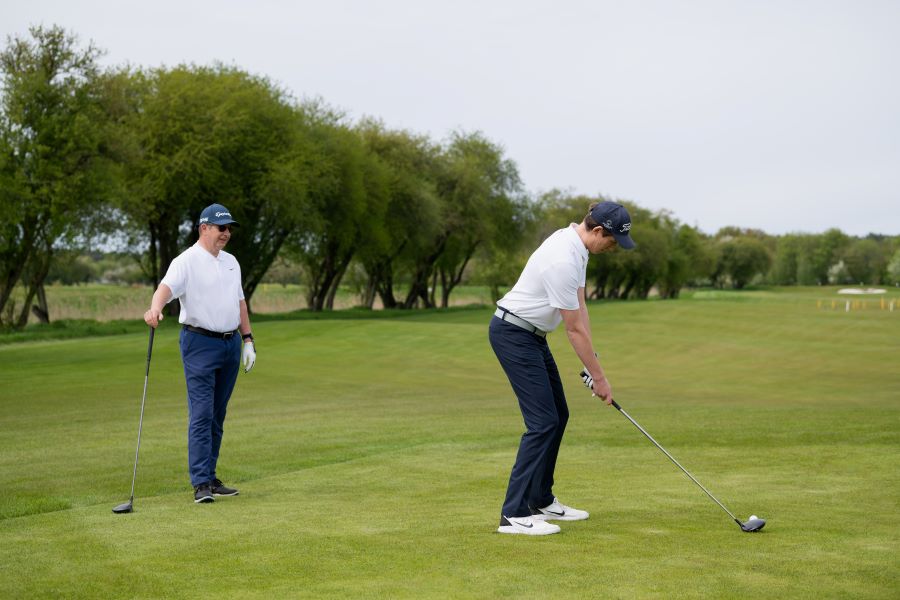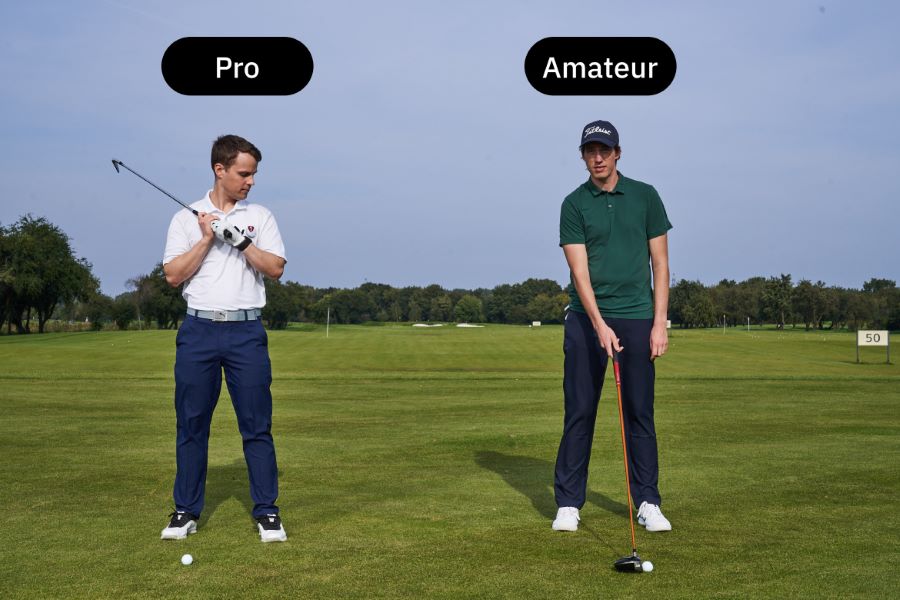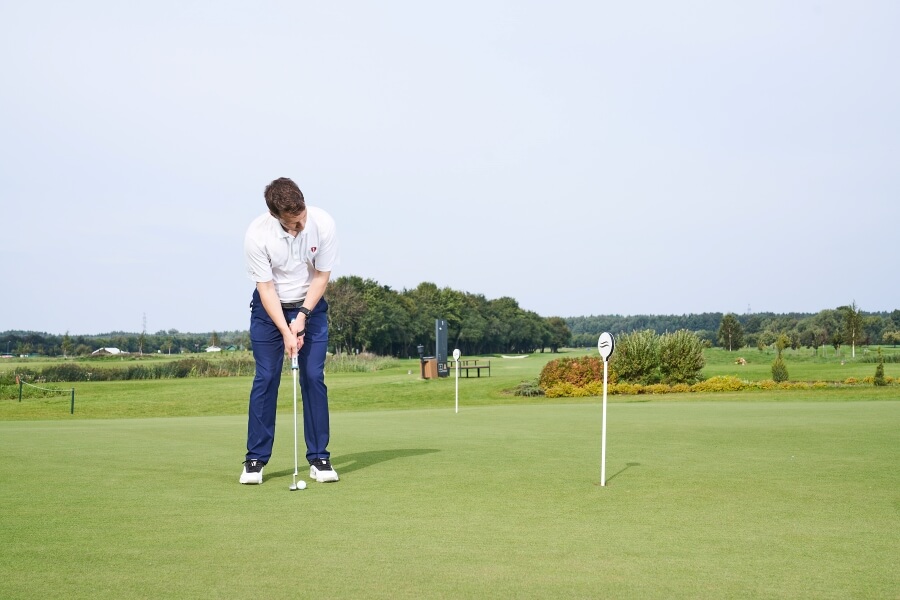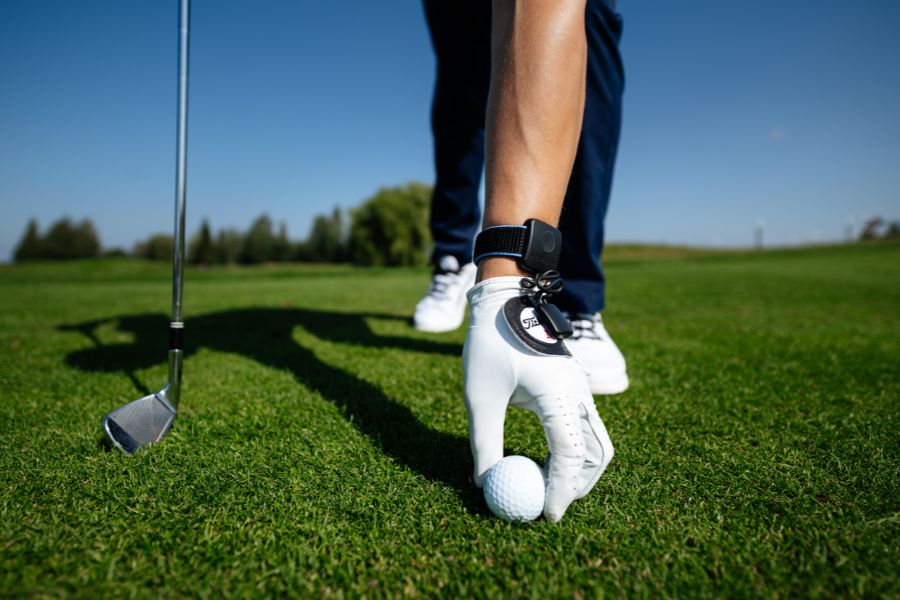The 9 Essential Tips for Playing Golf in Windy Conditions
With golf being an outdoor sport, the elements, including wind, come into play regularly. Considering how small a golf ball is, it makes sense that the strength and direction of the wind are two of the top outside elements in the game.
It’s tricky to master the wind and to be honest, it’s much more about managing its influence rather than conquering it.
It’s time to jump in! Let’s get you more informed and prepared for your next windy day on the links!
Contents
- Understanding the Science – How Different Winds Affect a Golf Ball
- 9 Essential Tips for Playing Golf in the Wind
- How to Prepare for a Wind in Golf – Pre-Round Check
- How to Prepare for a Wind in Golf – Pre-Shot Observations
- How to Prepare for a Windy Round – Your Frame of Mind
- How to Prepare for a Windy Round – Your Golf Ball May Matter
- Hitting Shots in Windy Conditions – Set Up Checkpoints
- Hitting Shots in Windy Conditions – The Swing
- Maintain a Regular or Even Slower Swing Speed
- Hitting Shots in Windy Conditions – The Short Game Shots
- Hitting Shots in Windy Conditions – On the Putting Green
- FAQ’s
- Summing it Up
Understanding the Science – How Different Winds Affect a Golf Ball
We will start with an overview of how different wind conditions affect the flight of a golf ball.
From wind direction, including downwind, into the wind, and crosswinds, to wind speeds, all will have specific influences on the ball.
The following chart is my solution to help you understand how headwind and downwind scenarios influence shots.
The bases of these calculations come from general rules of thumb that are known in golf regarding wind. These are only rules of thumb; variations will come from the shot trajectory, ball speed, and spin characteristics.
Headwind – add 1% to your distance to the hole for every 1mph of headwind.
| Distance to Pin | Windspeed Tailwind (+1% per 1 mph) | Influenced Distance to Pin |
|---|---|---|
| 100 yards | 15 mph (+15%) | 115 yards |
| 100 yards | 20 mph (+20%) | 120 yards |
| 100 yards | 25 mph (+25%) | 125 yards |
| 100 yards | 30 mph (+30%) | 130 yards |
| 150 yards | 15 mph (+15%) | 172.5 yards |
| 150 yards | 20 mph (+20%) | 180 yards |
| 150 yards | 25 mph (+25%) | 187.5 yards |
| 150 yards | 30 mph (+30%) | 195 yards |
| 200 yards | 15 mph (+15%) | 230 yards |
| 200 yards | 20 mph (+20%) | 240 yards |
| 200 yards | 25 mph (+25%) | 250 yards |
| 200 yards | 30 mph (+30%) | 260 yards |
Downwind – add 0.5% from your normal carry distance for every 1mph of downwind.
| Normal Carry Distance | Windspeed Headwind (+ 0.5% per 1 mph) | Converted Carry Distance |
|---|---|---|
| 100 yards | 15 mph (+7.5%) | 92.5 yards |
| 100 yards | 20 mph (+10%) | 90 yards |
| 100 yards | 25 mph (+12.5%) | 87.5 yards |
| 100 yards | 30 mph (+15%) | 85 yards |
| 150 yards | 15 mph (+7.5%) | 142.5 yards |
| 150 yards | 20 mph (+10%) | 140 yards |
| 150 yards | 25 mph (+12.5%) | 137.5 yards |
| 150 yards | 30 mph (+15%) | 135 yards |
| 200 yards | 15 mph (+7.5%) | 192.5 yards |
| 200 yards | 20 mph (+10%) | 190 yards |
| 200 yards | 25 mph (+12.5%) | 187.5 yards |
| 200 yards | 30 mph (+15%) | 185 yards |
IMPORTANT items to make a note of:
The following are only rules of thumb based on a stock shot. The trajectory of a shot will play a role.
A ball hit at a lower trajectory into the wind will not be as affected by the headwind. A ball hit higher into a headwind will be more affected by the wind.
Conversely, with a tailwind, a ball hit higher will carry slightly further than the chart indicates, and a ball hit lower will not gain as much advantage as the chart suggests.
When side winds come into play, you must consider the sidespin on the ball based on your shot shape.
For example, if you are a right-handed golfer hitting a fade into a left-to-right wind, the ball will move more left to right. Depending on the wind speed and based on the chart, you can roughly determine how much more it will move left to right.
Conversely, if you are a right-handed golfer that hits a draw into that same left-to-right wind, the ball will move less from right to left. The chart will roughly indicate how much less is based on wind speed.
9 Essential Tips for Playing Golf in the Wind
I will break up these nine tips into two categories: preparing to hit shots in windy conditions and playing shots during a breezy round.
How to Prepare for a Wind in Golf – Pre-Round Check
Since golf is indeed an outdoor sport and is very much influenced by the elements, it is highly recommended to check the weather forecast before you head out to the course.
Weather forecasting seems to get better and better by the day. While rain predictions are sometimes hit-and-miss, the wind is usually much more predictable.
The night before your round, make it a point to check the hourly forecast for the times you will be on the course. There are plenty of places where you can get this information. From your laptop to your phone, there are countless options.
You want to specifically look for the wind speed and direction concerning the course you will be playing.
Some great apps to download and have on your phone include:
- Weather Underground (Android, iOS: Free, Upgrades Available)
- Weather Channel (Android; iOS: Free, Upgrades Available)
- WeatherBug (Android; iOS: Free, Upgrades Available)
- My Radar (Android; iOS: Free, Upgrades Available)
- Windy (Android; iOS: Free, Upgrades Available)
How to Prepare for a Wind in Golf – Pre-Shot Observations
Learn to observe what is happening around you on the course. There are several areas you can look to as you gather wind-related information.
Here are just a few…
Flagsticks on your hole as well as neighboring holes nearby – look at several spots as you gather your information. Looking at one alone, such as the flag of the hole you are playing, may not give you the entire picture of what you face.
Look up in the treetops – looking up at the treetops and even further up at the clouds can give you even more critical information. Remember, by looking at the flag you are playing to, you only get part of the needed intel.
You literally can have wind still at the surface and gusting higher up. Additionally, you can have wind moving in one direction at the height of a flagstick and in another direction at the level of the treetops.
Your golf ball will reach its apex much higher than the height flagstick in most cases.
How to Prepare for a Windy Round – Your Frame of Mind
In the first two rounds of THE PLAYERS Championship in 2022, wind gusts as high as 30 mph made playing conditions insane on some of the scariest holes in golf.
This led to high scores and tons of golf balls finding the water on 16, 17, and 18. Relive some of the carnage at TPC Sawgrass during last year’s PLAYERS.
As you see from the reactions from the previous video, even the world’s best players can become incredibly frustrated by windy conditions.
Hands down, wind is one of the most unpredictable and frustrating outside factors in the game.
You must learn to maintain your composure while playing in windy conditions. Go into the day with the understanding that you will catch bad breaks as you go.
Also, remember, especially if you are playing in a tournament, that the entire field is playing in the same harsh conditions.
How to Prepare for a Windy Round – Your Golf Ball May Matter
When we talk about wind and its effect on the golf ball, no matter the direction or speed, the outcome of shots revolves around the ball’s spin.
That is the case even on calm days, but when the breeze is up and blowing, how the golf ball spins can and will influence the carry distance and curvature.
That said, playing a golf ball that matches your swing characteristics is essential.
A fascinating conversation to take note of can be found in the following video from GolfTEC. In it, they stop by PING Golf Headquarters to chat about the recent findings from their Ballnamic research. Well worth the watch.
Hitting Shots in Windy Conditions – Set Up Checkpoints
After you have gathered all the necessary information regarding the wind and are ready to hit the shot before you, it’s time to execute.
Before that, however, I want to go down a quick list of checkpoints to consider that will help you fly the ball the way you want to based on the conditions.
If you want to hit something low into the wind:
- Ball position should be back a touch.
- If hitting off the tee, tee the ball down more than normal.
- Choke down a bit on the club.
- Take the appropriate amount of extra club (consider the chart from earlier).
If you want to hit something a little higher, riding the wind when it’s at your back:
- Ball position should be up very slightly.
- Add a little more secondary spine angle (get lead shoulder higher than trail).
- Club down as necessary for the conditions (consider the chart from earlier).
If you want to shape a shot, riding a cross wind:
- Ball position played as usual for shape of shot you are looking to hit.
- Club up or down as necessary for the conditions (consider the chart from earlier). If looking to hit a right-to-left shot into a right-to-left crosswind, you should club down (for righties). Conversely, if you want to hit a left-to-right shot into a right-to-left wind, you should club up (again, for righties). The opposite is true for the reverse wind and shot shape scenarios.
- One of the most important things to consider in crosswinds is to use your best guess on your start lines for the shot you want to hit. The wind speed and amount of curvature you want to have the ball move back toward your target will determine where your start line should be.
Hitting Shots in Windy Conditions – The Swing
Set up is done, and you are ready to roll. It’s go time! The following tips will help you in the execution of into-the-wind, downwind, and crosswind shots.
If you want to hit something low into the wind:
- Get in all pre-swing positions as mentioned above in tip #4.
- Remember to swing at a normal tempo.
- You will still want to fully turn, but you will have a limited hand path as you go back.
- Rotate through on the downswing as normal.
- Focus on getting into a good impact position with hands leading.
- Through impact, and on to the finish, you will want to hold off your finish, with your hands lower.
If you want to hit something a little higher, riding the wind when it’s at your back:
- Remember to swing at a regular tempo.
- You will swing back and to the top as normal.
- Rotate through on the downswing as usual and feel as though you are slightly swinging up on the ball.
- Focus on getting into a good impact position with hands leading.
- Through impact and on to the finish, you will want to finish with your hands higher than usual.
If you want to shape a shot, riding a crosswind:
- Get in all pre-swing positions as mentioned above in tip #4.
- If you are “riding the wind” or shaping it with the direction it’s blowing, follow the downwind suggestions.
- If you are “holding it up against the wind” or shaping it against the direction the wind is blowing, follow the suggestions for headwind shots.
Maintain a Regular or Even Slower Swing Speed
One of the most critical things to consider when playing in windy conditions, especially in headwinds, is to swing at a normal or even a slightly slower speed.
You must take more club and resist the urge to swing hard when dealing with headwinds. This will be detrimental to the outcome of your shot as it will tend to balloon up and go too high.
It is essential to understand that swinging at a slower speed does not mean decreasing your swing tempo.
Your tempo is the rate at which you swing, meaning the ratio between your backswing speed and your downswing speed. You should swing at about a 3:1 ratio. This means your downswing time is three times faster than your backswing swing time.
The speed is the mph of your overall swing. The tempo is the rate or ratio of your backswing compared to your downswing.
You want to avoid deceleration on your downswing. Be sure to understand the difference between speed and tempo.
Hitting Shots in Windy Conditions – The Short Game Shots
As the loft of your clubs increases, the higher the shots will go. That is true with or without the effects of the wind.
When it is blowing hard, the wind even more so affects the ball. Learning how to flight your wedges at different trajectories is vital to playing good golf and scoring well.
Additionally, learning to use your different wedges is equally essential.
That said, being good at flighting your wedges and using the different lofted wedges in your bag while playing in the wind will undoubtedly save you strokes over your competition. This goes for small shots around the green and one out to 100-to-120-yard shots.
Short-game specialty shots, such as high lobs or bunker shots, require your ability to play the wind when necessary.
When hitting these higher shots into the wind, you can use those conditions as an opportunity to be aggressive. The wind will act as a backstop of sorts. It gets a bit deicer on downwind wedge shots. These must be carefully planned out as you must decide the trajectory to hit your shot into the pin.
Hitting Shots in Windy Conditions – On the Putting Green
Even when the ball is on the ground, the wind affects how the ball moves once stroked. The following are some best practices for putting in windy conditions:
- Make sure you have a solid base – if strong enough, the wind can push you around a bit as you try to get steady over the ball on the putting green. Stability is one of the most critical aspects of putting well. Make sure you have a solid and stable base in windy conditions. This may mean having to widen your stance a bit.
- Wind directions will influence putts in similar ways as full shots – even though your ball is on the ground, strong winds can still affect the roll of the ball in putting.
- Into the wind putts – these will require a little more pop to your stroke.
- Downwind putts – ease off on the speed of your putts downwind.
- Side wind putts – consider a little extra break if the wind blows hard enough.
FAQ’s
How much does wind affect a golf ball?
The wind can have a dramatic effect on the golf ball in flight. It is one of the most influential outside forces in golf. Not paying close attention to the wind and its influence could mean much higher scores.
Does wind affect putting?
As mentioned in tip #8, even when the ball is on the ground, the wind could affect how the ball moves once stroked.
Can you play golf in 20 mph wind?
Although challenging, you can play golf in winds of 20 mph. You have to understand how the wind can affect the ball and have a good plan of attack on how to battle it. Of course, proper execution means everything.
When is it too windy for golf?
In tournament play, it can indeed get too windy to continue play. One of the most significant indicators is when a ball does not stay in place when on the putting green.
It has happened numerous times on the PGA Tour. In February 2023 in the third round of the AT&T Pebble Beach Pro-Am, play was paused at 12:20 p.m. due to high winds. By 2:48 p.m., play for the day was called as conditions did not improve.
Summing it Up
Nothing can cause as much havoc and carnage during a round of golf as the wind can. With golf being an outdoor sport, the elements, including wind, can become a mighty force.
I hope this article will inform you of the wind’s influence on your golf ball in flight and how you can plan appropriately for it.
To execute the shots necessary to be successful in the wind, you must understand and plan correctly and have practiced enough in those situations to perform when the time comes.















